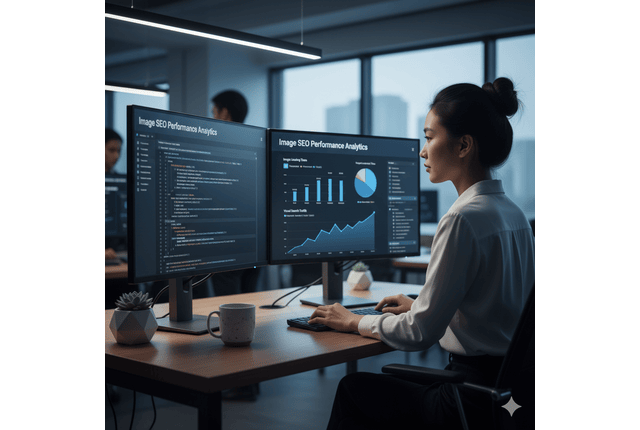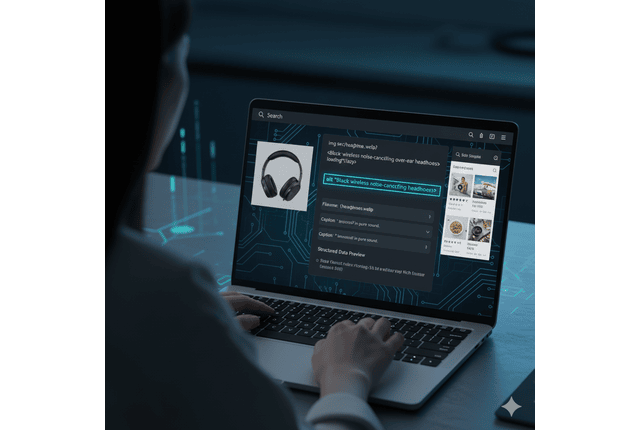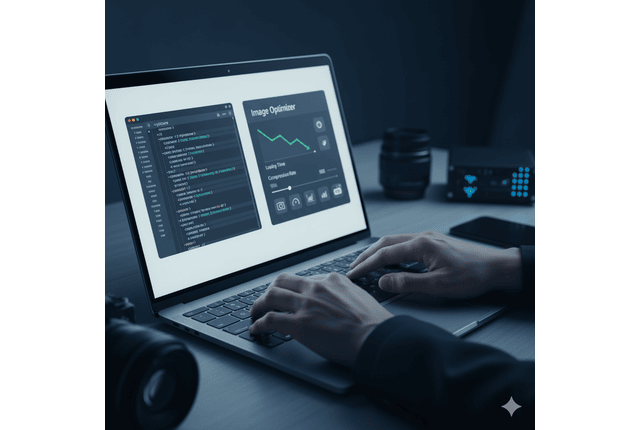In 2024, the web is overwhelmingly visual. Yet, a vast majority of websites still fail at Image SEO, treating image files as mere decorations rather than crucial ranking factors. If you’re serious about capturing the massive, underutilized organic visibility from Visual Search and dominating the Google Images ranking, you need a comprehensive strategy.
This is the definitive guide by SEO Agency Australia experts to mastering the technical, structural, and creative elements of image optimization. We will ensure every pixel on your site contributes positively to your Core Web Vitals and drives qualified Image traffic.
A. The Technical Battlefield – Performance and Speed
The battle for top rankings is now fought on the grounds of speed and performance. Unoptimized images are the single biggest drag on website loading times. Mastering the technical elements of Image SEO is non-negotiable for improving your Image loading speed.
1. File Format and Compression Mastery
The first step in Image SEO happens before you even upload the file.
- Image File Size Reduction & Compression: Every image must undergo aggressive Image compression. You must strike the perfect balance between quality and file size. Lossy compression tools (like TinyPNG) perform effective Image file size reduction by intelligently stripping out non-essential data.
- Next-Gen Formats: Google explicitly recommends serving Next-gen image formats (e.g., WebP, AVIF). WebP is generally 25-34% smaller than a comparable JPEG and supports transparency, making it ideal for the web. Use automated tools or plugins to convert and serve these formats, providing fallback JPEGs for older, unsupported browsers.
- Choosing the Right Format: Understand the use case:
- JPEG: Best for complex photos (lossy).
- PNG: Best for graphics, logos, and images needing a transparent background (lossless, but often larger).
- SVG: Best for icons, logos, and illustrations (vector, scales infinitely without quality loss).
2. Loading Strategy: Delivering Images the Smart Way
Even compressed images need smart delivery to maintain high Core Web Vitals scores.
- Lazy Loading Images: Implement Lazy loading images for non-critical assets (those below the fold). This means the browser delays fetching the image file until the user is about to see it, ensuring a faster Largest Contentful Paint (LCP) time. Use the native HTML loading=”lazy” attribute whenever possible.
- Image CDN (Content Delivery Network): For high-traffic sites, using an Image CDN (Content Delivery Network) is crucial. CDNs host your images on geographically distributed servers, drastically reducing latency and boosting global Image loading speed. Many CDNs also handle automatic compression and format conversion for you.
- Responsive Images: Never upload a file larger than it will be displayed. Use the <picture> element or srcset attributes to serve Responsive images. This ensures a user on a small phone only downloads a small file, not a desktop-sized one.
- Browser Caching: Configure your server headers to enable aggressive Browser caching for static image files. This instructs the user’s browser to store the image locally, preventing repeat downloads for returning visitors and reducing server load.
B. The On-Page SEO Essentials – Context and Indexing
Search engines cannot “see” an image; they rely on contextual clues. The proper implementation of on-page elements is what bridges the gap between a visual file and an indexed ranking asset.
1. Textual Cues: Speaking to the Crawlers
- Alt Text (or Alt tags): This remains the king of Image SEO. The Alt text (or Alt tags) must be descriptive and accurate for accessibility.
- Rule of Thumb: Describe what is in the image and its function relative to the page content. Naturally weave in your focus and LSI keywords, but avoid keyword stuffing.
- Image File Names: Before uploading, rename your file from generic strings (DSC00456.jpg) to descriptive, hyphenated Image file names (image-seo-guide-core-web-vitals.webp). This provides the very first, basic context signal to the search engine.
- Caption Text: The Caption text is the most user-visible element. Studies show captions are often read first. Use this space for engaging, informative text that reinforces the main topic of the image and the surrounding paragraph, improving Contextual relevance.
- Image Title Attributes: While less impactful for Search Engine Optimization than Alt Text, the Image title attributes can be used for supplementary descriptions or for display in specific contexts, aiding accessibility.
- Image Placement: Always ensure Image placement is logical and close to the relevant text. An image detailing “alt text best practices” should not be placed next to a section about “image compression.”
2. The Power of Code and Metadata
These elements provide structure and guidance to search engine robots.
- Image Structured Data: Implement Image structured data (or Image schema markup), especially for rich results like recipes, products, or videos. This is crucial for appearing with enhanced visual features in the SERP, directly improving your visibility.
- Image Sitemaps: Create and submit dedicated Image sitemaps via Google Search Console. This is how you notify Google of all your images, including those loaded via JavaScript or those not easily discoverable through the standard page crawl.
- EXIF Data: While not a primary ranking factor, metadata like EXIF data (Exchangeable Image File Format) can provide contextual signals, especially for photographers or original visual creators, regarding authenticity and technical details.
C. Audit, Visibility, and Advanced Strategies
The final stage of a complete Image SEO strategy involves continuous improvement and maximizing your reach across the entire search ecosystem.
1. Continuous Auditing and QA
- Core Web Vitals Monitoring: Regularly monitor your site’s performance using the Lighthouse report or PageSpeed Insights. These tools provide clear, actionable data on image-related issues, such as improperly sized images or those that fail to use next-gen formats. They are essential for any technical Image SEO audit.
- Image SEO Audit: Conduct a full site Image SEO audit to identify:
- Missing or poor-quality Alt text.
- Images that are unnecessarily large.
- Areas where Lazy loading has failed or been improperly implemented.
2. Maximizing Visual Search & Traffic
Your goal is to be found wherever people are searching for visuals.
- Google Images Ranking: Consistent technical optimization and great contextualization (Alt text, file names, captions) will naturally improve your Google Images ranking, driving substantial, targeted Image traffic.
- Visual Search & Google Lens: Optimization is the prerequisite for visibility in the growing areas of Visual Search powered by tools like Google Lens. High-quality, original images with precise alt text are more likely to be featured.
- E-commerce and Niche Optimization:
- For retail, E-commerce image optimization demands unique product angles, high-resolution details, and proper Product Schema to win shoppers.
- For certain industries, optimizing images specifically for Pinterest SEO, using relevant keywords in the image description and caption, can be a huge boost to referral traffic.
- Image Source/Licensing: Use Schema.org markup to clearly define the Image source/licensing. This can help protect your work and may lead to inclusion in Google’s structured image viewer, providing credit and driving direct traffic to your content.
Image SEO Best Practices
This section details the critical actions necessary for maximizing the effectiveness of your visuals, ensuring every element is optimized for both speed and search visibility.
1. Mastering On-Page Context
- Alt Text Quality: Beyond simply describing the image, the Alt text (or Alt tags) must serve as a descriptive replacement for the image for screen readers and search bots. Avoid keyword stuffing; instead, write naturally descriptive text that includes your focus keyword when contextually appropriate.
- Contextual Relevance: The proximity of your image to related body text is vital. Google uses surrounding paragraph content, headlines (H1/H2), and captions to assess an image’s Contextual relevance. Place your visuals near the specific text they illustrate.
- Image File Names: Before uploading, ensure your Image file names are descriptive and concise, using hyphens to separate words. This is the simplest way to give search engines a head start in understanding the image topic.
- Caption Text: Utilize the Caption text, which is highly visible, to further reinforce the image’s purpose and the page’s topic. This improves the user experience and provides another contextual signal.
- Image Placement: Always consider Image placement for better flow and user experience. Large, featured images should be near the top, and supporting visuals should break up large blocks of text.
2. Structural & Advanced Indexing
- Image Structured Data: Implement proper Image structured data (or Image schema markup), especially for products, recipes, and videos, to help your images appear as rich results in the SERP. This directly boosts your Google Images ranking visibility.
- Image Sitemaps: To guarantee that all your media is discovered, even if it’s loaded via JavaScript or a CDN, create and submit dedicated Image sitemaps to Google Search Console.
- Responsive Images & Lazy Loading: Use the appropriate HTML markup (srcset, <picture>, or the native loading=”lazy” attribute) to serve Responsive images and enable Lazy loading images. This is paramount for achieving high Core Web Vitals scores.
- EXIF Data & Licensing: For original visual assets, maintaining relevant EXIF data (Exchangeable Image File Format) can help establish ownership. Additionally, use schema to declare Image source/licensing to protect your work and potentially earn badges in image search results.
Tools for Image SEO
Effective Image SEO requires the right software to automate technical tasks and provide insightful audits. Using the correct tools can handle the heavy lifting of Image file size reduction and performance analysis.
1. Performance and Audit Tools
- PageSpeed Insights & Lighthouse Report: These Google tools are essential for diagnostics. Running your pages through PageSpeed Insights or checking the Lighthouse report will give you a clear, quantified assessment of your Core Web Vitals. They explicitly flag images that need compression, resizing, or conversion to Next-gen image formats (e.g., WebP, AVIF).
- Image SEO Audit: Dedicated crawling tools (like Screaming Frog or others) can perform a site-wide Image SEO audit to quickly uncover instances of missing or empty Alt text and identify images with excessively large file sizes.
2. Optimization and Conversion Tools
- Image Compression Tools: Use applications like TinyPNG, Compressor.io, or dedicated Image optimization plugin (e.g., for WordPress) to perform lossy Image compression, reducing file size without a noticeable quality drop.
- Image Resizer Tool: Utilize a precise Image resizer tool (like specialized software or CMS features) to crop and scale images exactly to their maximum display dimensions, preventing the browser from wasting time downloading unnecessary pixels.
- Image CDN: Services like Cloudflare, Imgix, or Key CDN function as an Image CDN (Content Delivery Network), not only accelerating delivery but often offering automated optimization, including format conversion and dynamic resizing, based on the user’s device.
Conclusion
Image SEO is complex, encompassing everything from server-side configuration and Image compression to on-page HTML markup. At SEO Agency Australia, systematically tackling all phases, ensuring minimal file sizes through WebP and AVIF, speeding up delivery with Image CDN and Lazy loading, and perfecting on-page signals like Alt text and Image structured data, we stop letting images slow your site down and start leveraging them as powerful, traffic-generating assets. Master these 2024 essentials, and you will not only improve your technical SEO but also unlock a new dimension of organic traffic.
FAQs
How do images primarily affect my SEO and Core Web Vitals?
Images are often the largest files on a page, directly impacting load speed. If they are not optimized (compressed or lazy-loaded), they slow down your site, negatively affecting your Core Web Vitals scores, especially Largest Contentful Paint (LCP), which Google uses as a key ranking signal for user experience.
Which image format should I use in 2024?
The best formats are Next-gen image formats (e.g., WebP, AVIF). They offer superior Image compression and smaller file sizes compared to older JPEGs or PNGs while maintaining quality. You should use a tool to convert your images and serve them using the <picture> element with JPEGs as a fallback for maximum compatibility.
What is the difference between compression and resizing?
- Resizing changes the dimensions (width and height) of an image to match the size it will be displayed on your page, which is essential for Responsive images.
- Compression reduces the Image file size reduction (KB or MB) without changing the dimensions, typically by removing non-essential data (lossy) or re-encoding the file (lossless). Both are crucial for maintaining Image loading speed.
Should I use an Image CDN or host my images myself?
For most growing or large sites, an Image CDN (Content Delivery Network) is highly recommended. It caches and distributes your images across global servers, reducing latency and dramatically improving Image loading speed for users worldwide. Many CDNs also automate optimization tasks like compression and format serving.
What is the single most important on-page factor for Image SEO?
The Alt text (or Alt tags) is the most critical on-page factor. It provides a textual description of the image for accessibility and helps search engines understand the image’s Contextual relevance. Your focus keyword should be included in the alt text where natural and descriptive.
How do I choose the best Image File Name?
Rename your image file from generic strings (e.g., IMG_4567.jpg) to a concise, descriptive name using hyphens to separate words (e.g., essential-2024-image-seo-guide.webp). This simple step provides the first strong SEO clue to the search engine crawler.
Why do I need an Image Sitemap and Structured Data?
- Image Sitemaps provide search engines with a clear list of all your image URLs, improving their discovery, especially if your images are loaded via JavaScript or Lazy loading images.
- Image Structured Data (or Image schema markup) adds explicit context (e.g., specifying an image as a “product photo” or “recipe thumbnail”) which helps you qualify for rich snippets and enhanced visibility in Google Images ranking.
How can I check if my images are hurting my site performance?
Use Google’s free tools: PageSpeed Insights or the Lighthouse report. They will flag issues like uncompressed files, missed opportunities for Next-gen image formats, and slow loading times, giving you a clear technical Image SEO audit checklist.
Why is Image SEO important beyond normal Google search?
Optimizing your images is essential for Visual Search and emerging technologies like Google Lens. It also drives significant Image traffic from Google Images ranking, which can be highly transactional, especially in niches like e-commerce where E-commerce image optimization is key.





